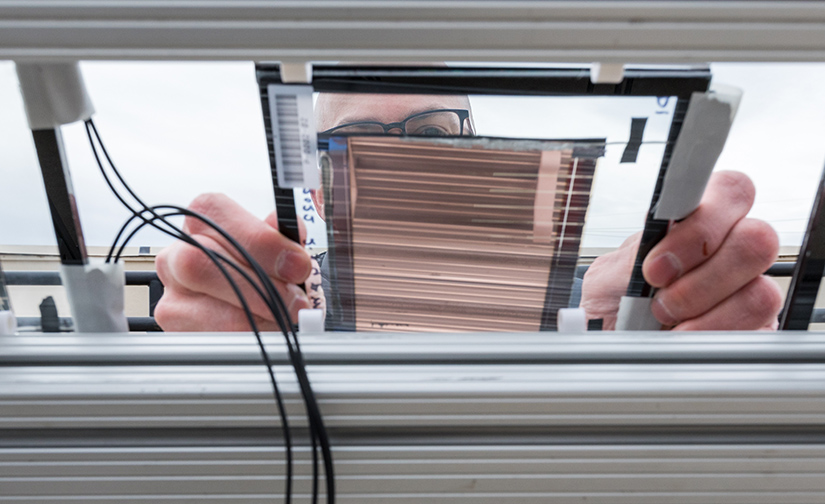A U.S. research team has fabricated a mini perovskite solar module based on a special polymer hole transport layer material that reportedly improves the panel stability and efficiency.
“The stability of perovskite modules has not been demonstrated to meet the required 25 years lifetime in many applications,” the research’s corresponding author, Jinsong Huang, told pv magazine, noting that the group was able to build the panel after identifying an ultraviolet (UV) light-induced perovskite degradation mechanism as one of the main causes affecting perovskite module stability.
“We report degradation mechanisms of p-i-n–structured perovskite solar cells under unfiltered sunlight and with LEDs,” the scientists explained, adding that they initially detected the cause of UV light-induced degradation in outdoor testing in the weak chemical bonding between the perovskite layer, the hole-transporting materials (HTM) and the transparent conducting oxide (TCO) layer at the cell level. “This causes perovskite solar cell degradation under sunlight with strong UV components.”
To mitigate the effects of this degradation, the scientists upgraded the perovskite solar cells used for the mini modules with a hybrid HTM based on a combination of EtCz3EPA, a new molecule, and poly[bis(4-phenyl)-(2,4,6-trimethylphenyl)-amine bathocuproine (PTAA:BCP).
This combination purportedly resulted in a stronger interconnection layer at the interface of the perovskite and the substrate in outdoor testing. “We enhanced the bonding at the perovskite/HTM/TCO region via a phosphonic acid group that bonded to the TCO and via a nitrogen group that interacted with lead in perovskites,” the academics explained.
The cells were based on a substrate made of indium tin oxide (ITO), the novel HTM, the perovskite absorber, a buckminsterfullerene (C60) electron transport layer, bathocuproine (BCP), and a copper (Cu) metal contact.
The 15 cm2 perovskite solar module fabricated with this cell configuration was able to achieve a power conversion efficiency of over 16% and retain these efficiency levels for around 29 weeks of outdoor testing. The results were confirmed independently at the U.S. Department of Energy’s Perovskite PV Accelerator for Commercializing Technologies (PACT) accelerator.
“Real-world demonstration is a critical step towards commercialization, and we hope by PACT offering these capabilities researchers and companies can leverage this data toward improved reliability,” the researchers said.
Their work is described in the paper “Strong-bonding hole-transport layers reduce ultraviolet degradation of perovskite solar cells,” published in Science. The research team had members from the University of North Carolina, the Colorado School of Mines, the National Renewable Energy Laboratory (NREL), the University of Toledo, and the University of California San Diego.
“This research is a true collaboration between organic synthetic chemists and solar cell device engineers working together to solve big problems. Furthermore, the chemistry to prepare the molecule of interest in this study is relatively simple and just the tip of the iceberg,” stated Alan Sellinger, a professor at Colorado School of Mines in a press release. Looking at upcoming research projects, Huang said that the group will continue to “understand the degradation mechanisms and find methods to overcome them.”
This content is protected by copyright and may not be reused. If you want to cooperate with us and would like to reuse some of our content, please contact: editors@pv-magazine.com.








By submitting this form you agree to pv magazine using your data for the purposes of publishing your comment.
Your personal data will only be disclosed or otherwise transmitted to third parties for the purposes of spam filtering or if this is necessary for technical maintenance of the website. Any other transfer to third parties will not take place unless this is justified on the basis of applicable data protection regulations or if pv magazine is legally obliged to do so.
You may revoke this consent at any time with effect for the future, in which case your personal data will be deleted immediately. Otherwise, your data will be deleted if pv magazine has processed your request or the purpose of data storage is fulfilled.
Further information on data privacy can be found in our Data Protection Policy.